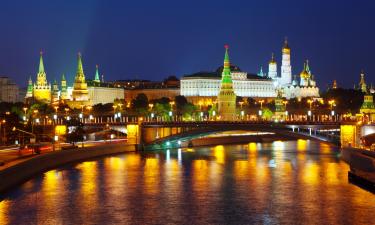Closed Towns Open Their Doors To Everyone
 Russia is making increasingly energetic attempts to integrate into the modern global community and is therefore lifting the veil of secrecy from many of its classified facilities. The formerly closed towns of Novouralsk, Snezhinsk, Angarsk, Zelenogorsk, Zheleznogorsk and others have already appeared on ordinary maps. Moreover, these towns are now open to visitors, though they need the appropriate authorisation. Sarov and Los Alamos, nuclear centres of Russia and the US, are twin towns today, something which could only be dreamed about only relatively recently.
Russia is making increasingly energetic attempts to integrate into the modern global community and is therefore lifting the veil of secrecy from many of its classified facilities. The formerly closed towns of Novouralsk, Snezhinsk, Angarsk, Zelenogorsk, Zheleznogorsk and others have already appeared on ordinary maps. Moreover, these towns are now open to visitors, though they need the appropriate authorisation. Sarov and Los Alamos, nuclear centres of Russia and the US, are twin towns today, something which could only be dreamed about only relatively recently.
However, Sarov has not been opened up completely. The town recently hosted the festivities dedicated to the 100th anniversary of the canonisation of Seraphim of Sarov, the most revered saint of the Russian Orthodox Church. Few pilgrims were allowed into the town to pray in the church built where St Seraphim's monastic cell once stood.
Sarov, formerly Russia's classified town Arzamas-16, is home to 86,649 people the majority of whom are nuclear specialists working for the Russian Nuclear Centre, one of the country's top secret facilities. The town is still surrounded by a barbed wire fence, while you have to present a special pass at one of the several checkpoints to enter or leave it. The locals, however, do not feel like changing the status quo, as the town's closed status is a guarantee of comfort and security.
The pilgrims were aware that Sarov was a closed town. They patiently waited in a field near Sarov for the procession with its holy relics in a cedar coffin to pass by.
Closed towns (and there are ten of them in Russia) are a fact of life in any civilised society.
The US has classified towns of its own, for example, Los Alamos in New Mexico. This is, probably, the most impressive example of secrecy. An ordinary cattle ranch lost in cornfields was a good disguise for the first underground laboratory for atomic physicists. Construction began during WWII. It would have never occurred to anyone that a simple shed was a disguised entrance to a super secret elevator, taking future Nobel Prize winners to brightly lit underground labs.
The fact that the existence of such classified monsters and their inmates is being brought into the open somewhat eases international tension. Atomiad, or the all-Russian Games for athletes from Russia's closed towns, is held near Moscow every autumn. In 2002, Novouralsk launched an international campaign, the Young Generation Against a Nuclear Threat, which involved over 100 students and professors from American closed towns.
Moroever, Russia's Nuclear Energy Ministry has repeatedly promised to gradually ease secrecy around such towns, and eventually lift the classified status from major nuclear centres completely. Russia makes no secret of the amount of plutonium and enriched uranium it possesses. A total of 192 tons of the substances are stockpiled in 115 well-guarded facilities.
Openness pays off.
It was Baghdad's closed position and lies that gave the Bush administration formal grounds to start the war. Indeed, North Korea's closed position is provoking a new conflict today.
Anatoly Korolyov, RIAN
Subscribe to Pravda.Ru Telegram channel, Facebook, RSS!





